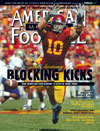AMERICAN FOOTBALL MONTHLY THE #1 RESOURCE FOR FOOTBALL COACHES
Article CategoriesAFM Magazine
|
Zone Blitzing the Spread OffenseHow elements like speed and spacing can be negated with a solid pressure packageby: Mike Kuchar © More from this issue There are some major philosophical components that need to be taken into consideration when coaches devise defenses. The first are structural concerns – what base front will you imply, even or odd? What will be your base coverage – will you be in a one high or two high safety defense? How will you defend the run game – will you be a “box” team that filters all perimeter runs to the middle of your defense, or will you prefer to “spill” everything to the perimeter, making the speed of your defense an asset as you run down offenses. When you start to focus on philosophy, you need to determine whether you will be a pressure defense or not. Teams that decide on bringing pressure have usually relied on bringing six to seven men on the snap, creating all out blitz circumstances. Sure, it sounds good and looks dynamic on ....The full article can only be seen by subscribers. Subscribe today!
|
|
|||||||
| HOME |
MAGAZINE |
SUBSCRIBE | ONLINE COLUMNISTS | COACHING VIDEOS |
Copyright 2026, AmericanFootballMonthly.com
All Rights Reserved





